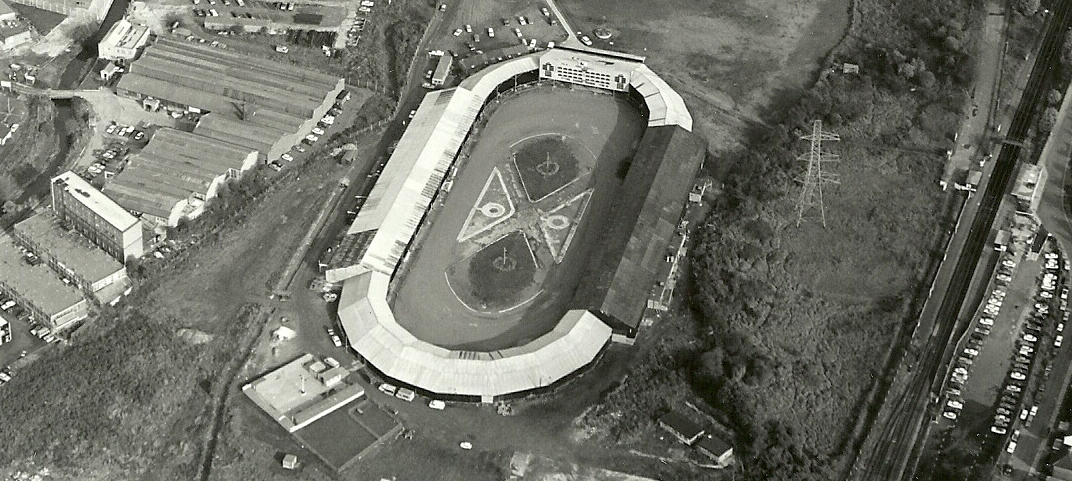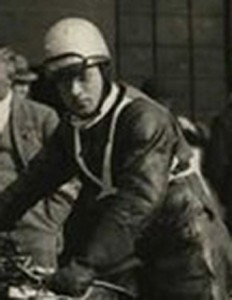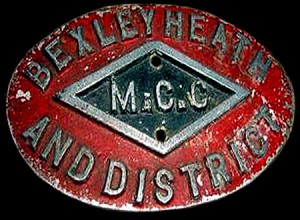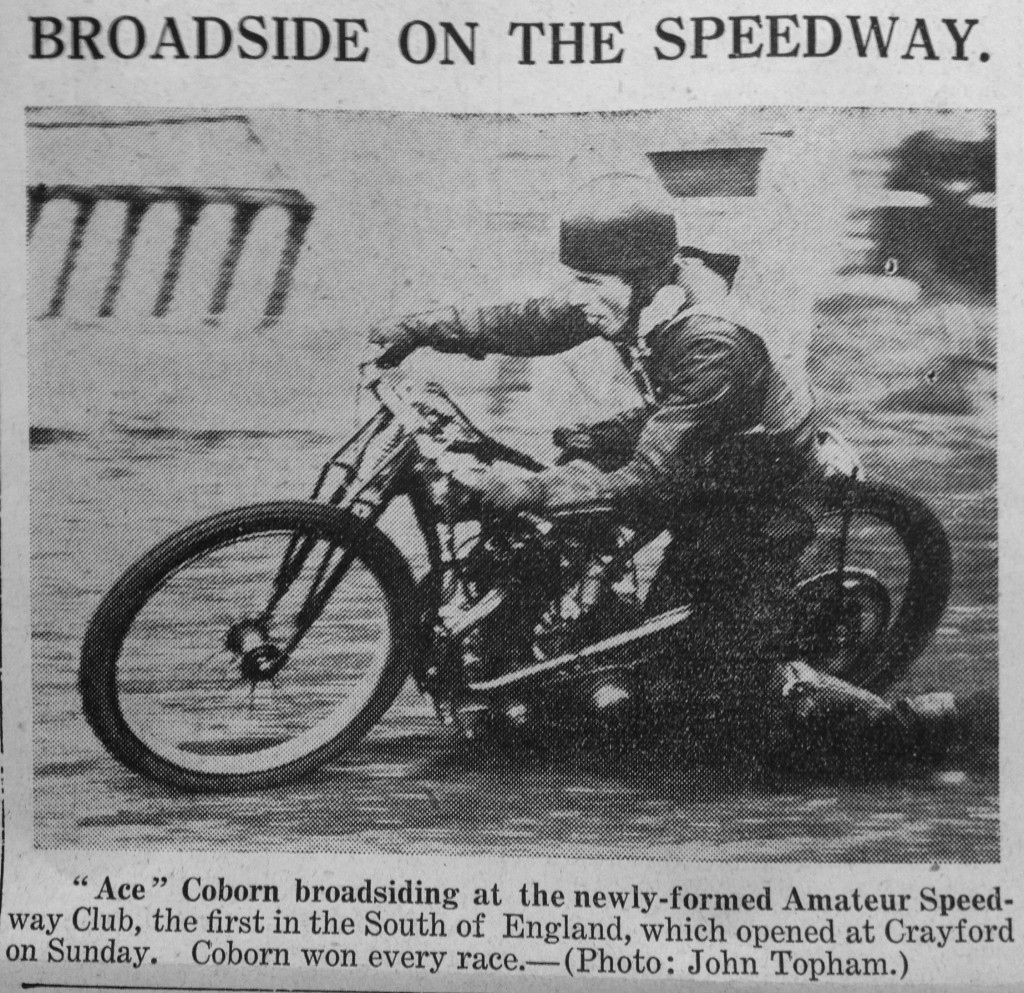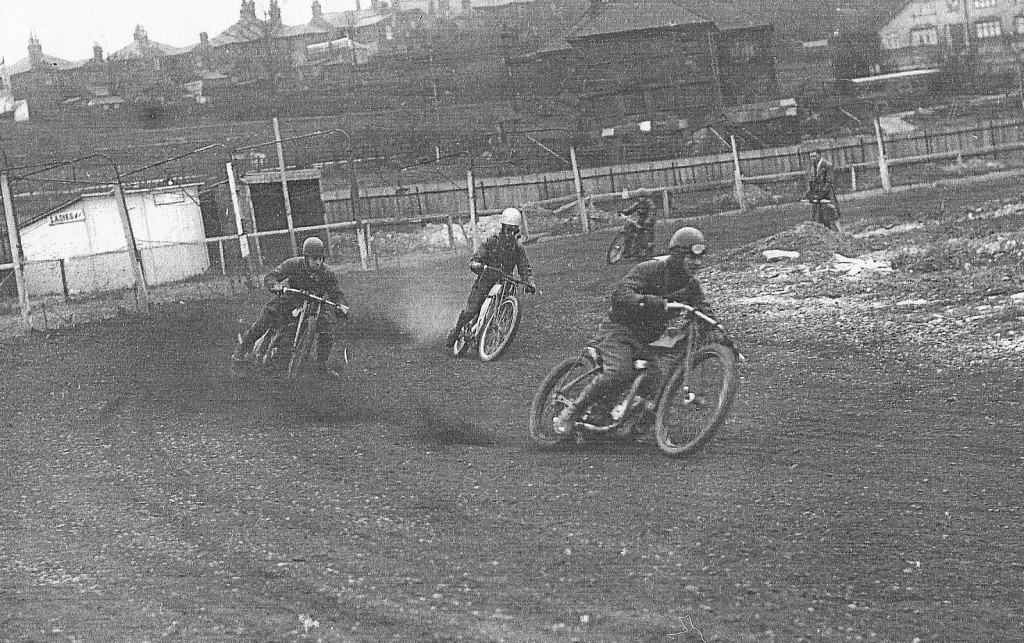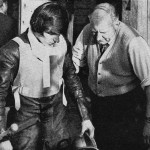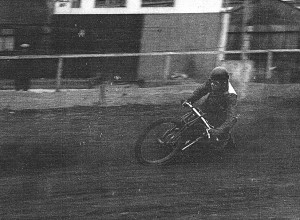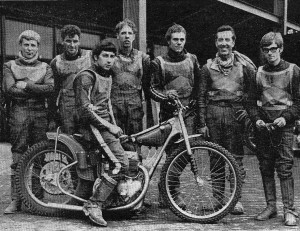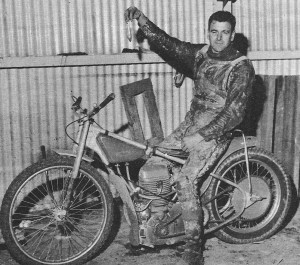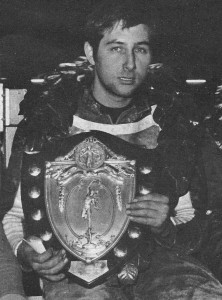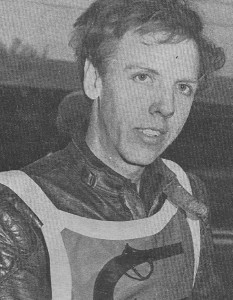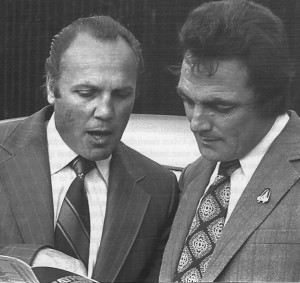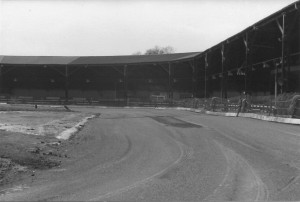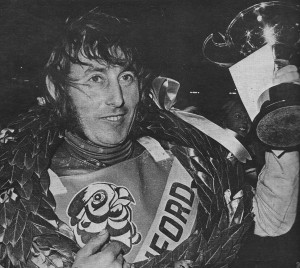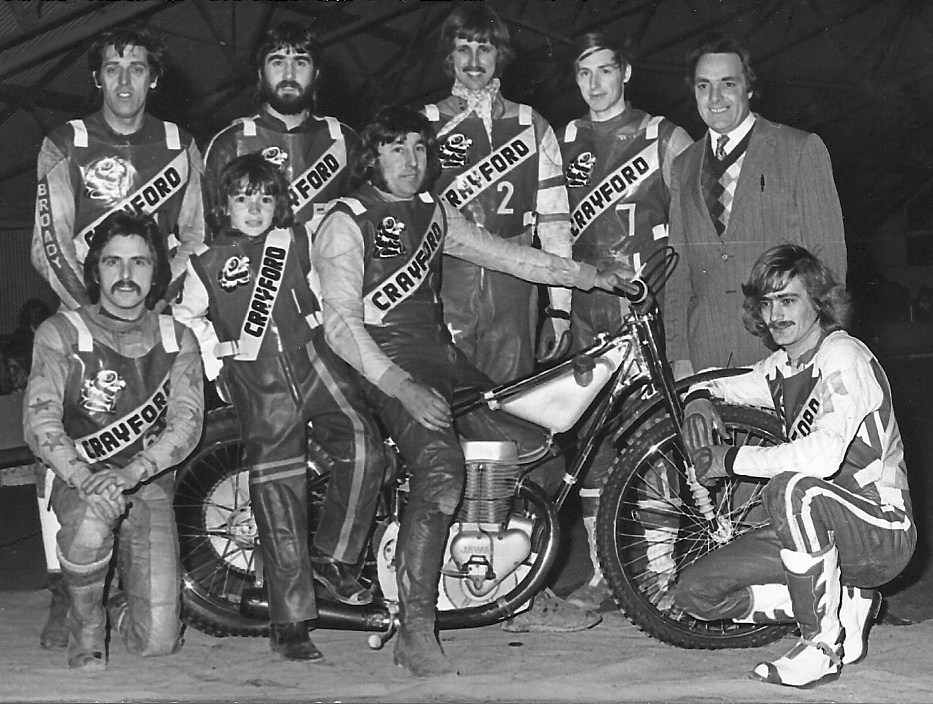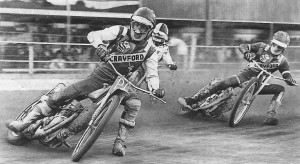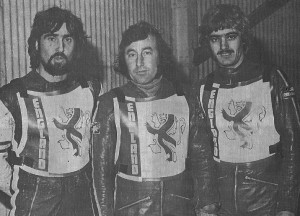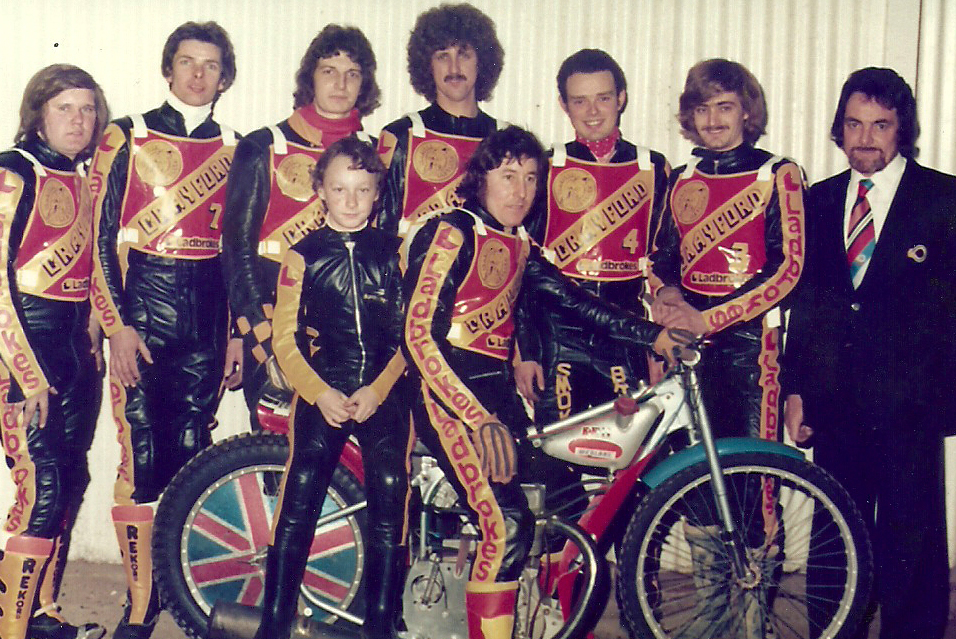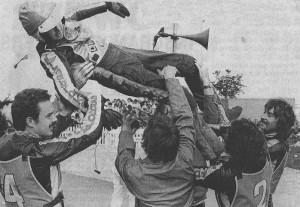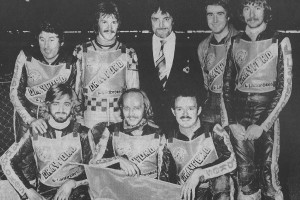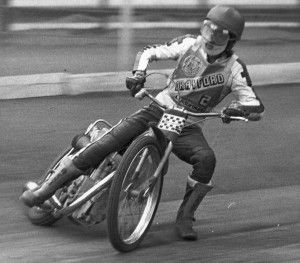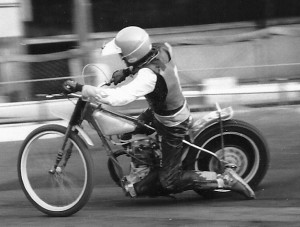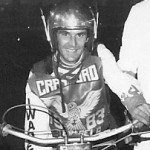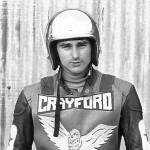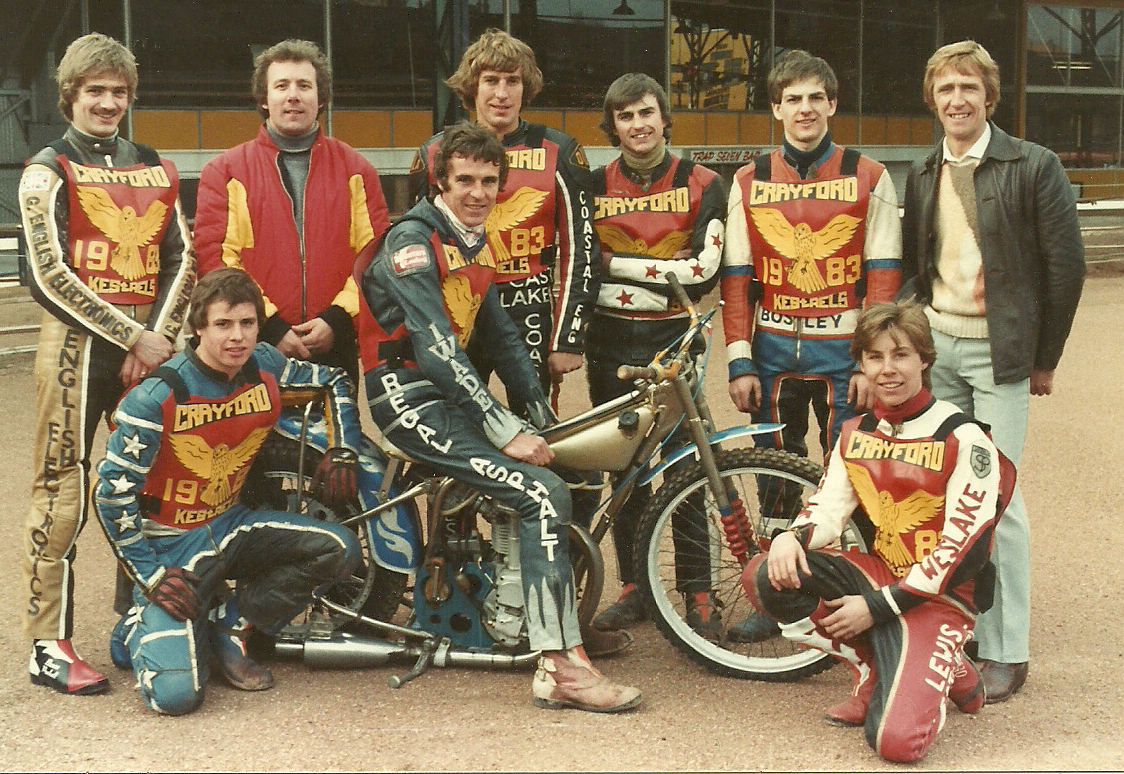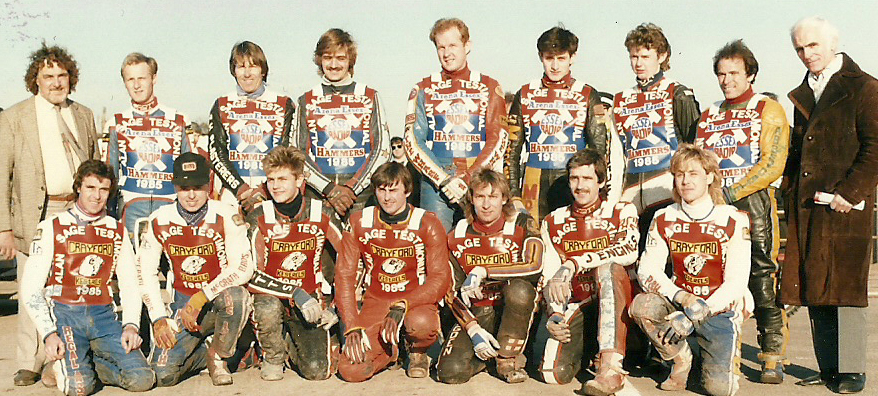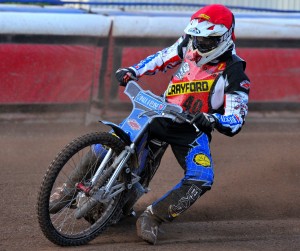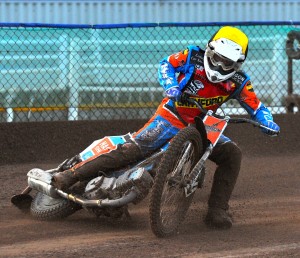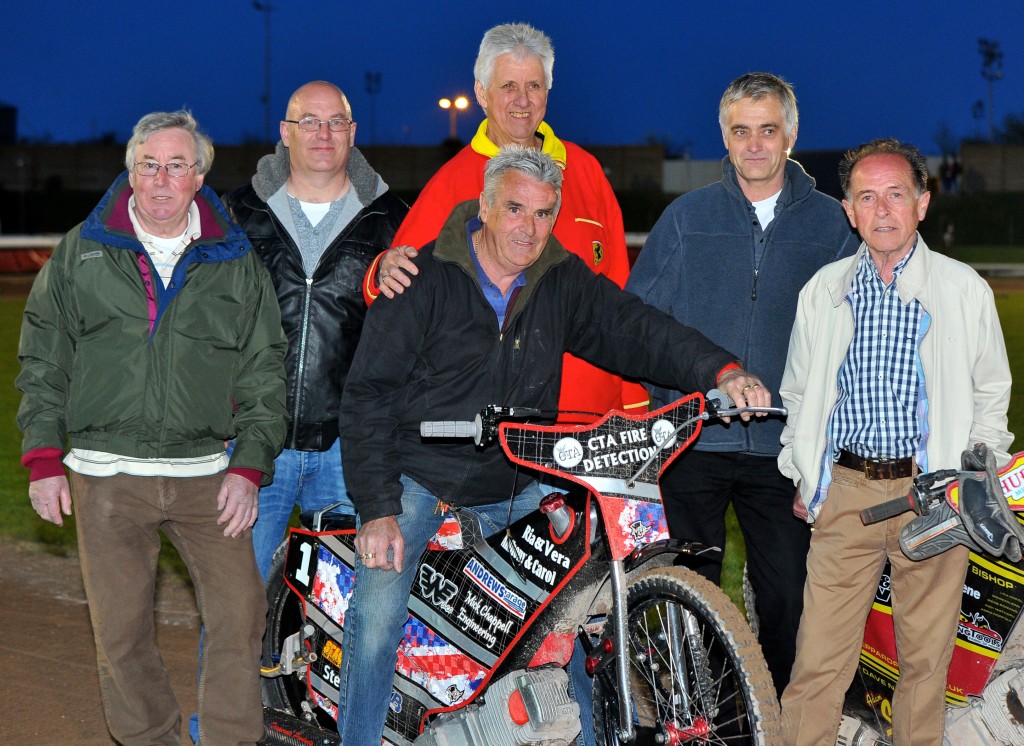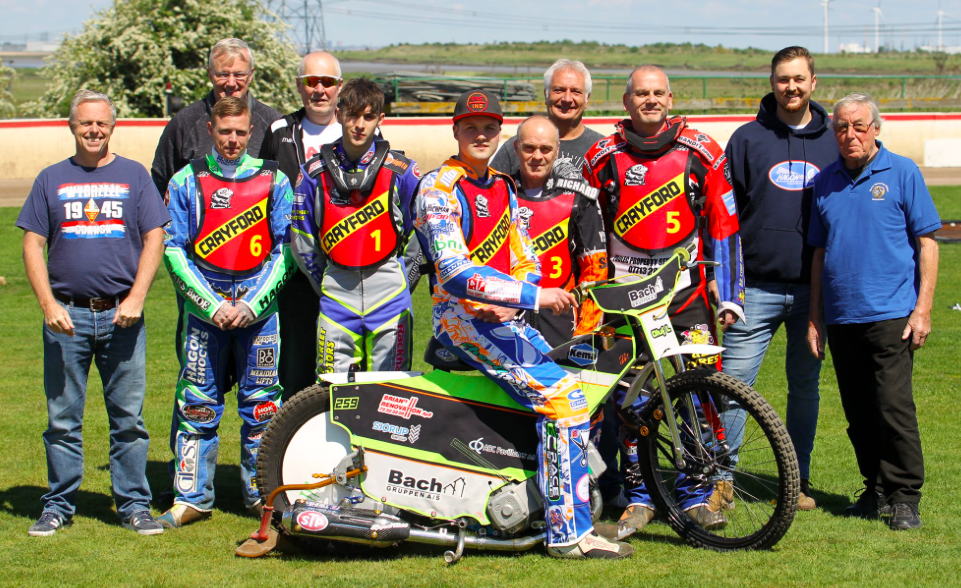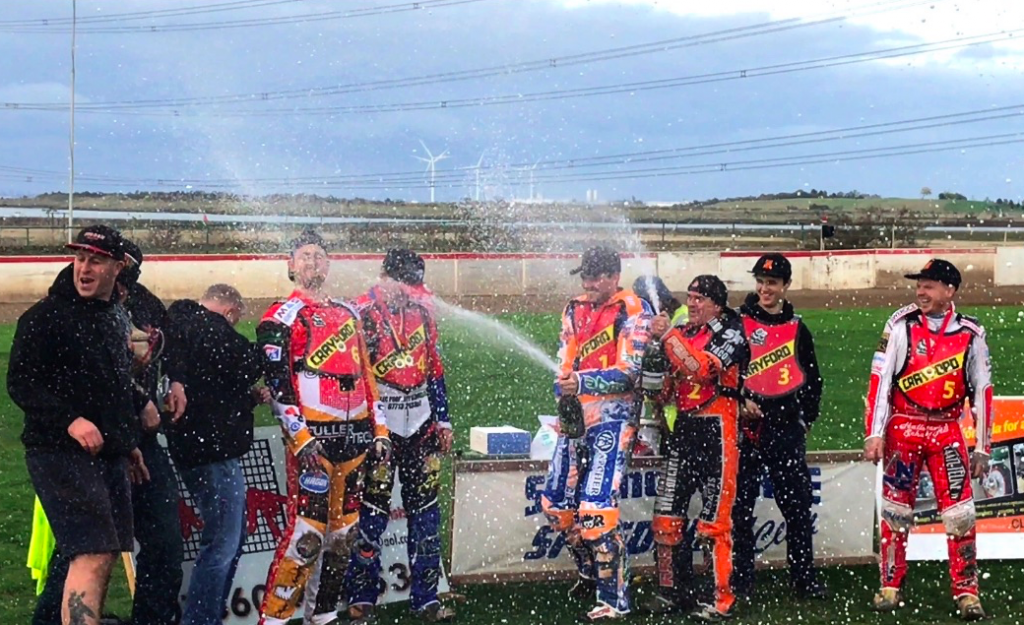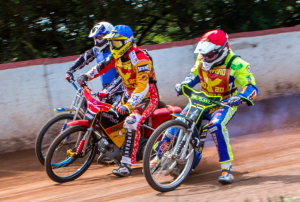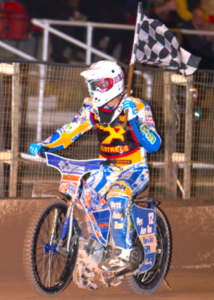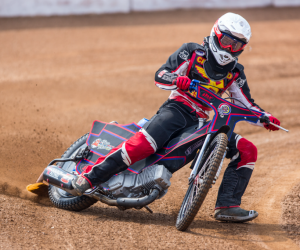The Pre-War Years
Originally the site of travelling fairs for over five hundred years, the ‘Crayford Fairfield’ was a patch of land located on the junction of the London-to-Dover Road and the London-to-Rochester Road. In the spring of 1930, it was idenitfied by the Bexleyheath & District Motor-Cycle Club as an ideal location to build a speedway track (on essentially a grass surface) and hold fourteen open meetings throughout the coming summer months.
1930
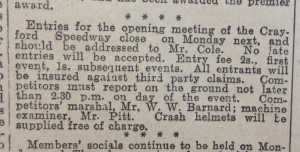 Initially an announcement appeared in the local Dartford Chronicle newspaper dated 21st March 1930 advising any Club members who anticipated racing on the newly established speedway track to contact the Clubs’ racing organiser, Mr GW Snowden. Then, three weeks later, the newspaper carried a further announcement (reproduced opposite) and following a practice session on the Saturday before, Crayford Speedway’s opening meeting was held on Easter Monday 21st April 1930 in front of “over 1,400 persons”. The afternoon’s racing was dominated by WJ Hewstone who won the Crayford Cup, Bexley Heath Cup, Solo Championship and both his match races against HW Osborne and EH Langman. Hewstone also set the track record with a winning time of 2m 12.5secs. The only other winner on the day was EAJ Angus who emerged victorious in the Dartford Cup event.
Initially an announcement appeared in the local Dartford Chronicle newspaper dated 21st March 1930 advising any Club members who anticipated racing on the newly established speedway track to contact the Clubs’ racing organiser, Mr GW Snowden. Then, three weeks later, the newspaper carried a further announcement (reproduced opposite) and following a practice session on the Saturday before, Crayford Speedway’s opening meeting was held on Easter Monday 21st April 1930 in front of “over 1,400 persons”. The afternoon’s racing was dominated by WJ Hewstone who won the Crayford Cup, Bexley Heath Cup, Solo Championship and both his match races against HW Osborne and EH Langman. Hewstone also set the track record with a winning time of 2m 12.5secs. The only other winner on the day was EAJ Angus who emerged victorious in the Dartford Cup event.
Following a mid-week open practice, the second meeting took place on the afternoon of Saturday 10th May. The programme mainly consisted of scratch and match races although the final event of the day was a 4-lap relay race between two teams of three riders. This race proved a fitting finale as Hewstone and Green dead-heated after a final two laps of “wheel to wheel” racing. The track record was lowered on two occasions, first by JA Hitchcock and then recaptured by WJ Hewstone with a time of 2m 5.4secs. The Bexleyheath & District MCC promoted their third meeting at the Crayford Speedway on Saturday 24th May where yet another large crowd witnessed, “the best racing yet staged on the track. Delays between events were reduced to a minimum, while the loud speakers showed vast improvement. The riding reached a high standard, and the applause given the riders at the end of the meeting was well deserved”. It was also announced that all future Saturday meetings would commence at 6pm, and not 3.30pm as previously.
Speedway continued throughout the summer months and attracted plenty of talented riders to the new track. One of the most celebrated was twenty-year-old Harold Daniell who hailed from nearby Forest Hill in South London. Daniell was to become one of the first ever stars of Crayford Speedway, winning the Plumstead Cup on 7th June; the Kent Cup on 22nd June and towards the end of the season also winning the Westminster Cup, Chelsea Cup and the Grade A Riders Championship. He also smashed the track record with a winning time of 1m 47 1.5secs on 22nd June. The final meeting of the season was held on Sunday 4th October when FL Oliver won a series of match races to collect the Barbara Cup. The Bond Championship Cup and the title of Club Speedway Champion was decided using the cumulative results from all the speedway meetings held throughout the season and was won by EAJ Angus (98pts) with HW Osborne (83pts) the runner-up. Harold Daniell remained the track record holder at the seasons end. The impressive Daniell went onto become a leading road racing and Grand Prix motor-cycle star winning the Isle of Man TT an incredible three times (1938, 1947 & 1948) and holding the Isle of Man lap record for over twelve years. He finally finished his motor-sport career racing Formula 3 cars at Brands Hatch in the early 1950s.
1931
Despite heavy rain and soggy track conditions, the new season opened on Easter Monday 6th April in front of a large number of spectators. Unfortunately, the wet spring continued resulting in a heavily flooded Crayford Fairfield and the Bexleyheath & District Motorcycle Club were only able to stage this sole meeting during the first five weeks of the season. It even forced them to set up a telephone hotline where interested parties were asked to, “phone Mr Snowden on Woolwich 1826 on day of event”. Thankfully, by early May, the weather had relented and the Club were able to begin their season in earnest. During the winter months they had decided to offer a number of local motorcycle clubs challenge matches over the standard six rider, nine heat format.
And so on Sunday 10th May, history was made when the first ever team match at Crayford Speedway was staged between Bexleyheath MCC and Sidcup MCC. In a one-sided affair, the homesters won by 37-17 with FL Oliver scoring a twelve point maximum and also winning the second half solo event. A week later, the Club sent a side down to Sunny Hill Speedway to race Sittingbourne, where unfortunately, they struggled to cope with the unfamiliar track losing 15-39. However, despite the defeat the team had travelled in style, with all the riders and their equipment transported down in a “team” lorry. The challenge matches continued at Crayford throughout the summer with the home side in dominant form. They trounced Darenth 41-11; gained revenge over Sittingbourne with a 40-14 thrashing and in the final team match of the season, they beat The Optimists 41-13. Such one-sided contests obviously produced an array of impressive statistics. At Crayford, home riders won all but two heats with FL Oliver (38pts) heading the scorers and unbeaten by an opposition rider. His four maximums would have been equalled by HW Osborne (27pts) but for an engine failure in the match against Sidcup. Other notable performances came from EA Angus (25pts), CA Lewis (20pts), EH Langman (12pts), R Williams (12pts) and last seasons star Harold Daniell, who made a rare but welcome return to Crayford, when he rode in the home match against Sittingbourne scoring a nine point maximum.
Due to the lack of competitive team opposition, the remaining home meetings reverted back to individual scratch, handicap and match race competitions. CA Lewis won the Crayford Silver Trophy and Treasurers Cup to go with his early season victory in the Crayford Cup. HW Osborne won the Chairman’s Cup and on 4th October, the Club promoted the ninth and final meeting of the season where J Collins emerged victorious to collect the Kent Cup. The end of season award of the Bond Championship Cup and the title of Club Speedway Champion went to HW Osborne (81pts) with CA Lewis (45pts) finishing runner-up. And the track record at the seasons end was held by HW Osborne with a time of 1m 46 2.5secs. At their Annual Dinner and Dance in January 1932, the Club Chairman, Mr RJ Holloway announced, “the speedway at Crayford, which proved such an attraction last season, would be given up”. He stated that although speedway had been a success, it was an experiment and the meetings had given them a lot of work. With the land at Crayford Fairfield now vacant, the expansion of greyhound racing in the area continued as Wilson Greyhound Racing Track Ltd stepped in and built a 450-yard dog track to rival the new venues at Sidcup and Dartford. Advertised as “The Ascot of Greyhound Racing”, the new track opened for business on Easter Monday 1932.
1935
At 8pm on the evening of Friday 16th August 1935, a meeting was held at Crayford Stadium to discuss the formation of an amateur dirt track riding club with the intention of resurrecting speedway racing after an absence of just over three years. The Club planned to use a cinder circuit laid inside the dog track and although smaller than the one that operated in 1930-31 before the greyhound track was built, this new speedway track would be much more akin to other existing local venues such as New Cross and Wimbledon. The newly formed Crayford Amateur Speedway Club, the first of its kind in the South of England, initially held a trial meeting on Sunday 18th August where ‘Ace’ Coborn set a track record of 87secs.
Then a week later on Sunday 25th August 1935, they staged the first official meeting of the new Crayford Speedway with ‘Ace’ Coborn once again showing his liking for the track, winning all his races and breaking his own track record by 4secs. Other riders known to have competed in this opening meeting were JC Parker, A Barrett, Alf Markham and Freddy Wiseman. Now officially branded the Crayford Speedway Stadium, meetings continued there every Sunday afternoon throughout the late summer and early autumn. Although the original intention was to only stage open individual events, towards the end of the season the Club decided to add a new dimension by promoting two special team contests. On Sunday 22nd September, despite heavy rain, the first match took place between two sides of six riders representing the North and the South. The six-heat match saw some extremely competitive racing with the North, captained by Arthur Mason and ably supported by team-mate Pat Taylor, emerging victorious by 23-12. Owing to bad weather, the following weeks meeting was postponed but on 6th October the return match was staged with the South, including the impressive Bill Weston and Pip Daily, gaining revenge with a 27-9 victory and an overall aggregate win of 39-32. It was also announced that with, “the track rapidly gaining enthusiastic supporters among the spectators”, a Crayford Speedway Supporters Club had been formed with HL Thornton as its secretary.
Sunday 13th October, saw Crayford host a special series of match races between riders representing London and Leicester, with Paddy Mills of Leicester in dominant form. However, the meeting was marred by two nasty accidents, which saw both 19-year-old Frank Pollock (leg injuries) and 21-year-old William Giddy (face and back injuries) detained in hospital. 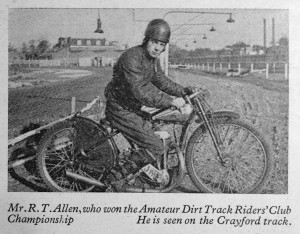 The final meeting of the season took place on Sunday 3rd November, when the Club held its Championship Cup and Claude Rye Cup events. RT Allen emerged victorious in both and in other end of season presentations, Freddy Wiseman won the Amateur Dirt Track Riders Points Cup for best overall performance throughout 1935 and Geoff Godwin from Leicester won the Gold Medal for the most points scored in a single meeting. Arthur Mason and Bill Weston jointly held the track record of 73secs at the seasons end, with Weston remarkably setting his record time in his first ever race at Crayford. As an aside, many years later in 1948, Weston was to gain notoriety as a stunt double in the speedway racing sequences of the BAFTA nominated film, ‘Once A Jolly Swagman’ starring Dirk Bogarde and he also raced in Barcelona, Spain in 1950, when an attempt was made to introduce the sport to the country.
The final meeting of the season took place on Sunday 3rd November, when the Club held its Championship Cup and Claude Rye Cup events. RT Allen emerged victorious in both and in other end of season presentations, Freddy Wiseman won the Amateur Dirt Track Riders Points Cup for best overall performance throughout 1935 and Geoff Godwin from Leicester won the Gold Medal for the most points scored in a single meeting. Arthur Mason and Bill Weston jointly held the track record of 73secs at the seasons end, with Weston remarkably setting his record time in his first ever race at Crayford. As an aside, many years later in 1948, Weston was to gain notoriety as a stunt double in the speedway racing sequences of the BAFTA nominated film, ‘Once A Jolly Swagman’ starring Dirk Bogarde and he also raced in Barcelona, Spain in 1950, when an attempt was made to introduce the sport to the country.
1936
For reasons that now lay lost in the midsts of time, the Amateur Club moved their operation to the new track at Dagenham for the 1936 season. However, speedway continued at Crayford under new ownership and still remained focused on amateur and novice riders. The new season opened on Sunday 5th April and meetings then continued throughout the summer months with the club racing every Sunday afternoon and admission to the public costing 1/- inc. tax. Unfortunately, press coverage of this season was virtually non-existent but riders known to have raced at the track during this period were John and Reg Guntrip, Archie Windmill, Wilf Jay and Wilf Plant. Interestingly, Plant who rode for Leicester, New Cross, Wimbledon and Middlesbrough, was the father of modern day speedway rider Graham Plant, who raced at Crayford in 1968, top scoring against the Highwaymen and then rode there again in the ’80s against the Kestrels.
In an interview about his early career Wilf Plant said, “They ran meetings in the same place, although there were no grandstands. I can remember the railway line running past the track. I was a junior in those days and got much of my early training at Crayford“. And to give just a flavour of the conditions under which these pioneers raced, Archie ‘Spider’ Windmill, who went onto ride for Hackney, Wimbledon, Walthamstow and Aldershot over a sixteen year career, had an amusing anecdote regarding a meeting he contested at Crayford as a young twenty year old, “at that time, the fencing was wire mesh on concrete posts” and in one of the races he hit the fence damaging both the fence and his leg, although neither seriously.
At the end of the racing he went, as was the custom, to the office to collect his pay earned that night, only to find they wanted to stop money from his point’s earnings to pay for the fence!
In 1937, not for the first time – or the last, speedway was unable to continue at Crayford, as the site was to be redeveloped for dog racing. Work on the new ‘Crayford and Bexleyheath Greyhound Stadium’ by builders W & C French of Essex had begun at the beginning of the year with the deadline of a mid-summer grand opening. Unfortunately, the new structure “erected in the Crayford Fairfield on the site of the former greyhound racing and motor-cycle dirt-track” at a cost of around £50,000 (equal to £2.8 million in 2012) was, as its new name suggested, designed for the sole use of ‘the dogs’. The new, state of the art stadium boasted two glass-fronted grandstands, a restaurant and was fully covered throughout offering greyhound racing spectators similar facilities to Wembley, White City, Wimbledon et al.
The Highwaymen Years
Over three decades had passed before Crayford was considered again as a venue for speedway. Enter onto the scene serial promoter and entrepreneur Mike Parker – who along with partner Bill Bridgett – had reopened speedway at another dog track at Wolverhampton in 1961 as a Provincial League outfit; and steered the Wolves into the new British League four years later. Three years into the great BL adventure, a new second division was to be formed and for such a brave new world, promoters like Parker were on the look-out for venues. Deeper into Kent, the then 75 year old founder of speedway itself, John S. Hoskins was to open the county’s first fully-fledged league track at the home of Canterbury City FC; and prompted by this incursion to the Garden Of England (an area where motor-cycle sport including grass track was already very popular), Parker and Bridgett found what seemed the perfect location for a nursery side for their Wolves in the Crayford and Bexleyheath Stadium.
So – with Parker also opening Stock Cars and Bangers in the stadium (and illustrating each of his motor sport endeavours on the front cover of the programme) – at last, speedway returned to Crayford on 12th June 1968 (just a month after Hoskins’ Canterbury had staged the first ever Division Two match) – Crayford beating another brand new club, the Nelson Admirals 50-27. When it came to riding personnel, the new north-west Kent side did very much have the flavour of a Wolverhampton second team about it, with no less than five riders in the initial line-up who’d been members of the West Midlands outfit the previous term: number one, Mick Handley, Derek Timms, Stuart Riley, Dave Parry and skipper Geoff Ambrose. Reappearing on the scene was Tony Childs – who’d had a season with Wimbledon in ’66. For a nickname, a local newspaper competition produced the romantic moniker: the Highwaymen – a nod to the area’s past infamous reputation as a haunt for those villains of the road of the eighteenth and early nineteenth centuries.
1968
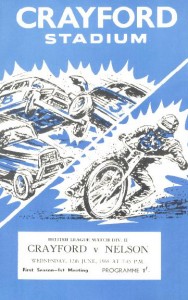 The Highwaymen had a solid first season in the sports second tier. They attracted some very good crowds, in fact attendances that many a First Division outfit would have been proud and finished in a respectable mid-table position. This was due in part to an excellent home record as visiting teams struggled to cope with the tricky London Road circuit.
The Highwaymen had a solid first season in the sports second tier. They attracted some very good crowds, in fact attendances that many a First Division outfit would have been proud and finished in a respectable mid-table position. This was due in part to an excellent home record as visiting teams struggled to cope with the tricky London Road circuit.
Interestingly, their home record nearly included a meeting hosted by Wolverhampton, when in mid September the local River Cray broke its banks and the Crayford track was submerged under three feet of flood water. Eventually, after deciding not to race at the Midlands track, the Highwaymen’s final league match against Plymouth went ahead over a month later at the end of October after the London Road circuit had been pumped dry and dead fish removed from the pits!
22 year-old Mick Handley finished top of the averages with an excellent 10.48 CMA. His outstanding contribution was complimented by respectable returns from both heat leaders and second string riders with Tony Childs (7.68), Derek Timms (6.54), Colin Clark (6.05), Dai Evans (5.88) and Geoff Ambrose (5.87) all posting solid numbers. Timms’ retirement towards the end of the season opened the door for Cradley Heath second-half rider, Archie Wilkinson, who grasped the opportunity with both hands making an explosive start for the Highwaymen. In the three matches Wilkinson contested at the tail-end of the 1968 season, he was beaten only once by an opponent to record an impressive 11.33 CMA.
1969
With parent club Wolverhampton recalling Mick Handley, last seasons top points scorer and star rider, Crayford could have been in serious trouble but with Archie Wilkinson now a regular and new team skipper and four of last years riders: Geoff Ambrose (10.03), Tony Childs (8.24), Colin Clark (6.17) and Tony Armstrong (5.27) all improving their averages, the Highwaymen rose up the table to finish an excellent fourth out of sixteen clubs.
Ambrose was a vastly improved rider, who capped a season where he nearly doubled his CMA by winning the Division Two Riders Championship at Hackney. In addition, the Highwaymen were the only team in Division Two to register an unbeaten home record and complimented this with a massive 54-22 victory at Berwick on April 19th – the largest ever away win recorded in either division of the British League and a match where the visiting Highwaymen won every heat. The result was all the more impressive because Crayford came from one of the smallest tracks in the country and Berwick’s was one of the largest. Individually, the Highwaymen continued setting records when Mick Steel created British League history by winning four consecutive heats in the match against Crewe and then went on to complete a five ride maximum in the space of just six heats; and Archie Wilkinson was involved in Division Two’s first ever dead-heat when he tied with Barry Crowson at Eastbourne.
1970
Just as they had done at the end of the 1968 season with Mick Handley, parent club Wolverhampton recalled last seasons equally, if not more impressive number one and reigning Division Two Riders Champion, Geoff Ambrose. His natural successor was Archie Wilkinson (9.55), who had already showed his undoubted talent in Crayford colours over the last two years and ably skippered the side last season. And true to form, Wilkinson stepped up to the mark, scoring over one hundred points in his first ten matches. Unfortunately for him and the Highwaymen, his season ended there. Struck down by a mystery illness initially diagnosed as an acute appendicitis, Archie was to spend the remainder of 1970 in and out of hospital whilst specialists tried to treat him. Although the team bravely soldiered on, led by Crayford stalwart Tony Childs (7.97) ably supported by newcomer George Devonport (7.00) and the return from Doncaster of Derek Timms (5.19), Wilkinson’s absence was noticeable and it was a miracle the team didn’t finish even lower than fourteenth of seventeen.
The poor League performance was compounded by the complicated circumstances under which speedway was promoted at the track. The early arrangement with the stadium landlords hadn’t allowed for stock cars and speedway to operate on separate nights within a contemporaneous season and so the two separate motor-sports had to share a race-night, meaning speedway couldn’t be guaranteed every Wednesday. The writing was on the wall when Parker and Bridgett hurriedly changed four Wednesdays in the middle of the school summer holidays from speedway fixtures to banger racing meetings. Clearly crowds for the motorcycling part of the promotion were not up to scratch; and with losses around £3,000 that year, the plug was finally pulled. It hadn’t been for want of tinkering with the product though. After the initial season, the quickly-becoming notoriously bumpy 300 yard circuit was torn up and a new grey quarry track (like the one Hoskins used at Canterbury) was laid.
So was a new drainage system: rain seemed to bedevil Crayford over all of the twelve years the stadium eventually was to stage speedway. Then at the end of the ’69 campaign there was major track re-modelling again: reducing down to a smallest in the country, 270 yards. Reviewing the three year existence of the Highwaymen, although Wilkinson, Timms, Clark and Armstrong all rode every season, one rider in particular stands out – Tony Childs. Not only was Childs ever-present, riding in every single one of the 83 league and cup matches Crayford contested, he also finished top three in the averages each season (1968 = 2nd 7.68; 1969 = 3rd 8.24 & 1970 = 2nd 7.97). And to illustrate just how dependent the ‘Men were on Childs at times, his performances on the 1970 Northern tour provide ample evidence. Over a period of just 24 hours, Childs scored 13 out of 26 points at Berwick and then 8 out of 15 at Rochdale – in each case scoring as many (or more) as the rest of the team put together!
The Kestrel Years
Motor-sport carried on at Crayford after 1970 in the form of stock car and banger racing but thankfully speedway’s absence was to last just a handful of years. When Len Silver and Peter Thorogood’s Rayleigh was sold for redevelopment at the end of 1973, the pair looked at a number of possible venues to re-home their operation.
After initially considering Southend Greyhound Stadium, they whittled down their short list to just two venues, training track Rye House and Crayford. Unfortunately, planning permission to stage speedway at Crayford had lapsed and so they moved their Rayleigh Rockets lock, stock and barrel into Rye House in time for the start of the 1974 season. Midway through that season developments took a twist as Thorogood recounts, “During that first 1974 season together at Rye House, Len took me aside to say that Crayford was likely to become available after all. I asked him if it was being considered instead of Rye House or in addition to, and he confirmed that he was keen to run both. We discussed me managing Crayford in 1975 in partnership with him while he sought a new co-promoter for Rye House.” And so, with an agreement finally brokered to allow speedway to run weekly on its own separate race-night (Tuesdays), the Crayford Kestrels were born with Thorogood at the helm as Promoter and Team Manager and Silver as a sleeping-partner. Determined to offer a better ‘product’ than the previous promotion, a number of changes were made to the track.
Measuring 265 yards, only slightly shorter than the final Highwaymen days, Silver and Thorogood altered the shape of the circuit to “more correct proportions, helping the riders to make racing more competitive and entertaining to the public“. To achieve this they re-shaped and added banking to each bend in addition to installing new soak-away drainage. They also tore up the old surface around the bends and put in a hard chalk base so that the stock cars would do less damage. Although these alterations were hampered by the atrocious weather conditions experienced in the build up to the opening of the season, the management aided by many volunteers, worked long hours to insure everything was completed in time.
1975
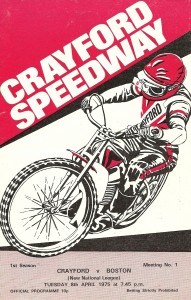 A rain sodden Tuesday 8th April 1975, saw the return of speedway to the Crayford and Bexleyheath Stadium with the Kestrels recording a 46-30 victory over a Boston side who had at reserve a young Michael Lee (later to win the 1980 World Speedway Championship) in their line-up. The new Crayford Kestrels had a distinctly Rayleigh Rocket look about them. Kent-based Trevor Barnwell, Les ‘Red’ Ott and former Wimbledon Don, Pete Wigley had all raced for Thorogood at Rayleigh in 1973 and Crayford’s new skipper and number one heat leader, Laurie Etheridge had begun his career at the Rockets back in 1968 before moving up midway through the following season to Silver’s Hackney Hawks, where he then spent the next six years in the top flight and gained a full England International cap in 1974. Veteran rider George Barclay moved over from Rye House and the main body of the team was completed by Alan Sage, who had been – like Barclay – a main-stay of the other East London side, West Ham before the famous Custom House Stadium’s closure had moved the whole team onto Ipswich. Sage had been ever-present in Division One with the Hammers and then the Witches for four consecutive seasons: it was a record of consistency that was to continue in spectacular style – completing an incredible 327 consecutive appearances in official fixtures before breaking his leg in July 1979.
A rain sodden Tuesday 8th April 1975, saw the return of speedway to the Crayford and Bexleyheath Stadium with the Kestrels recording a 46-30 victory over a Boston side who had at reserve a young Michael Lee (later to win the 1980 World Speedway Championship) in their line-up. The new Crayford Kestrels had a distinctly Rayleigh Rocket look about them. Kent-based Trevor Barnwell, Les ‘Red’ Ott and former Wimbledon Don, Pete Wigley had all raced for Thorogood at Rayleigh in 1973 and Crayford’s new skipper and number one heat leader, Laurie Etheridge had begun his career at the Rockets back in 1968 before moving up midway through the following season to Silver’s Hackney Hawks, where he then spent the next six years in the top flight and gained a full England International cap in 1974. Veteran rider George Barclay moved over from Rye House and the main body of the team was completed by Alan Sage, who had been – like Barclay – a main-stay of the other East London side, West Ham before the famous Custom House Stadium’s closure had moved the whole team onto Ipswich. Sage had been ever-present in Division One with the Hammers and then the Witches for four consecutive seasons: it was a record of consistency that was to continue in spectacular style – completing an incredible 327 consecutive appearances in official fixtures before breaking his leg in July 1979.
For his part, Etheridge (9.74) became, as one would have predicted, one of the top riders in what was now called the New National League – claiming the 1975 Riders Championship title following a run-off with Brian Collins and recording over one hundred heat wins in League and KO Cup matches. Not far behind him in the averages was the impressive Sage (8.51) and together these two riders were to provide the back-bone of the Kestrels almost throughout their entire nine year history. Barnwell finished the season with an excellent 7.73 CMA, winning the hearts of the Crayford fans with his do or die all-action style. Another popular Kestrel was Pete Wigley (6.26), who provided solid support and finished the season as Crayford’s third highest points scorer. Les Ott (5.78) hadn’t lasted long as a Kestrel, nor had another former Rayleigh Rocket, ex-skipper Bob Young (5.86); and for Barclay (5.34), it was a swan-song season (bowing out with an unforgettable twelve point maximum against Eastbourne). With George’s son, Terry unable to gain a team-slot, newcomer Bill Archer (4.11) came to prominence and the other reserve berth went to Alan Johns (5.68) – elder brother of Wimbledon international, Roger. Johns capped an impressive season with a faultless four ride paid maximum in the final home meeting, a superb Kent Cup victory over arch rivals Canterbury. Crayford’s comeback year saw the club finishing in a very respectable eighth position out of twenty teams. The London Road track was still the smallest in the country and had given the Kestrels a useful home advantage, although it’s interesting to note that Crayford opened their 1975 campaign with a 41-37 away win at Crewe, which at 430 yards, was one of the largest tracks in the League.
1976
Following last years successful reintroduction of the sport, the Kestrels management let their championship intentions known with the close season signing of Mike Broadbank (7.33). With seven World Final appearances; numerous full British International caps and a League winners medal, Broadbank was at the time possibly the most experienced man in British speedway.The current New National League Riders champion Laurie Etheridge (9.87) had another outstanding campaign, especially at London Road, where he was to drop just eight points all season registering an incredible 12 maximums (10 full and 2 paid) out of 17 matches. With another excellent contribution from Alan Sage (8.79), the Kestrels heat-leaders were a triple spear-head as good as any in the League illustrated by their combined haul of 1,000 points in official matches. Winning their first five League matches on the trot only reconfirmed the Kestrels desire to compete at the very top but unfortunately with Pete Wigley (7.22) suffering an injury plagued season, Crayford’s early momentum did not continue. Had they a fully fit Wigley at their disposal the Kestrels would definitely have finished higher than an already credible sixth of eighteen.
Alan Johns (6.54) and Bill Archer (5.45) gave the second string a solid look as did the emergence of youngster Richard Davey (4.71), who overcame three successive zeros then a broken collar bone, to return from injury and post a couple of double figure scores during the second half of the season. In the excellent but short-lived Inter-League Knock-Out Cup, the Kestrels nearly caused a massive giant-killing shock when the mighty Leicester Lions were on the very verge of defeat at London Road. All square going into heat 13, unfortunately Alan Johns fell in a heroic effort to clinch victory and the East Midlanders emerged with an agonising 40-38 victory.
1977
A regular feature of Thorogood’s team building was to bring in big names, who more often than not lasted just a solitary season and this close seasons revolving door featured the departure of the vastly experienced Broadbank and the introduction of another vastly experienced rider in the shape of 44 year old Colin Goody (8.53). Given the chance by Poole to drop down into the National League to see his speedway days out, Goody validated Thorogood’s tactics, proving an ideal replacement and firmly claimed the third heat leader role supporting the ever-consistent Laurie Etheridge (9.41) and Alan Sage (8.65). Unfortunately, the Kestrels second-string didn’t quite fulfil their potential leaving the squad with a distinctly top-heavy appearance. Alan Johns (5.47) missed the start of the season due to a contractual dispute and injury interrupted the campaigns of both Mike Bessant (4.22) and Gary May (3.78). Overall, a mid-table finish of tenth out of nineteen was a respectable effort although it left the Crayford faithful wondering what might have been had the lower order produced a stronger performance. The season also saw the National League debuts of Dingle Brown who had previously ridden at Crayford during the Highwaymen days as a visiting Rayleigh Rocket and Vic Harding, who was to sadly lose his life a couple of years later racing at Hackney for the Hawks.
1978
“The more things change; the more they stay the same” so the saying goes and so the Kestrels proved. The ‘changes’ came with the departure of Colin Goody and Mike Bessant who were replaced by Tony Featherstone (5.02) and the return of former track record holder Pete Wigley (5.19). Another ‘change’ was the take-over of speedway operations by leisure giants Ladbroke, who poured thousands into the promotion including kitting out the entire team in smart, matching red, gold & black Ladbroke Leisure leathers. ‘Staying the same’ was the final outcome of Crayford’s league campaign in which they finished in tenth position scoring 34 points, both exactly the same as the previous season. Also repeating last years performance was the dominance of the team averages by the ‘old firm’ Laurie Etheridge (9.34) and Alan Sage (8.53). With Featherstone struggling to find his form and then breaking his collar-bone mid-season, the popular Alan Johns (6.28) improved again and held the third heat leader slot by the end of the season.
A notable statistic for a 42 match league and cup campaign was the fact that the Kestrels had five ever-present riders in Etheridge, Sage, Johns, Richard Davey (5.18) and fan favourite John Hooper (4.36). It also saw the durable Alan Sage carrying his all-time record of successive League appearances in the second tier of racing to an unbroken total of 146 matches. The season also saw Crayford play host to a National League International match, England versus Australasia. The home nation side was captained by London Road specialist and five time winner of Crayford’s Kentish Times Trophy, Newcastle’s Tom Owen. Three Kestrel riders were included in the England line-up and whilst unfortunately Alan Johns didn’t manage to get a ride from the number eight reserve slot, both Laurie Etheridge and Alan Sage recorded six ride maximums.
This year also saw Crayford enter a team for the inaugural season of the Trackstar sponsored Anglia Junior League. The Kestrels junior side finished in an impressive 3rd place out of ten clubs with ‘star of the future’ Nigel Sparshott (8.47) and the stylish Jack Bibby (7.38) leading the averages. Interestingly, the home match versus King’s Lynn would have resulted in a record 15-0 whitewash but for a dubious point awarded to Peter Wordingham after both Lynn riders had fallen.
1979
Another mid-table (twelfth of nineteen) finish but this was more than just an average season for it saw a changing of the guard at the top of the averages.
Newcomer Steve Naylor (8.96), on loan from Eastbourne, immediately showed the Crayford fans his potential with a twelve point maximum on his home debut against a strong Weymouth side. Although displaced from their usual one-two spots, the ‘old firm’ Laurie Etheridge (8.14) and Alan Sage (7.95) continued to produce solid performances. However, for Sage the season and his record-breaking run of 163 consecutive League appearances ended in July when he broke his leg whilst guesting at Canterbury. The severity of his loss to the Kestrels at the crucial mid-season stage is aptly illustrated by his final two performances before the accident when, on July 17th in a double header against Scunthorpe and then Boston, Sage went through the meeting unbeaten by an opponent respectively recording a paid four ride maximum and a full four ride maximum. On a brighter note, Crayford also saw the arrival of another Eastbourne loanee, Paul Woods (7.68) who, like Naylor, rode impressively and soon became a firm favourite at London Road.
Crayford’s junior side had another excellent season, once again claiming 3rd place out of 12 clubs. The popular Jack Bibby (8.80) finished in the top ten of the Anglia Junior League averages and also scored more race points than any other rider in the League! And together with the impressive Paul Hollingsbee (8.32) and debutant Mike Pither (6.78), the Kestrels were more than a match for most teams, especially at home where they registered a 13-5 mauling of eventual League champions Mildenhall and a 15-1 demolishing of Cradley Heath.
1980
Without doubt the Kestrels most successful season so far. Although they finished in their usual mid-table League position, 1980 saw the club gain its first major title winning the National League Four Team Tournament Finals at Peterborough on 27th July, where shrewd team managing by Peter Thorogood enabled reserve Les Rumsey to take his full quota of rides scoring half of the teams 14 point total to clinch the title by one point from the ‘old enemy’ Rye House. As impressive and memorable was the level of support the team received at Peterborough, with coachloads of Kestrel fans making the journey north to fill the back straight banking and witness Crayford winning their first major honour.
The victory in the Fours completed an amazing fortnight for the Kestrels following a record breaking performance on Tuesday 15th July, when they played host to Workington in a double header and rode to a massive 65-12 victory. This was the first and only occasion an entire seven man team went unbeaten by an opponent through a thirteen heat match. As Thorogood recalls, “The four team win was a great day for the lads and for the fans but I can tell you that the record win over Workington was a real nail biter. When we got wind that we might be on for a record the lads got ever so nervous. No one wanted to be the rider to drop a point. The riders were a bag of nerves, but afterwards, well what do you think? They were over the moon. I think at the time the result got us in the Guinness Book of Records“. Although one 5-0 and twelve 5-1 heat advantages created two full and five paid maximums and meant an expensive night for the Crayford management, it did place the club into the record books with a score that essentially can now never be beaten.
Individually, Paul Woods (10.55) dominated the averages, ably supported by fellow Eastbourne loanee Steve Naylor (8.28) and Les Rumsey (7.89) signed in the close season from Oxford. Alan Sage (6.85) and Laurie Etheridge (6.02) continued to offer excellent support though both suffered injuries. Etheridge was struck down by an early season back injury and Sage fell victim to a mid-season broken collar-bone. As to be expected, they both took time to recapture their form but by the end of the season they appeared back to their old reliable selves. Rumsey became the first Crayford rider to win the Silver Helmet Match-race Championship when in April he beat Karl Fiala (Rye House), successfully defending the title against Steve Wilcock (Middlesbrough) in May before losing to Dave Perks (Oxford) the following month. However, the Helmet ended the season back in Crayford’s possession when Paul Woods defeated Mike Ferriera (Canterbury) in September and then successfully defended the final contest of the season against David Gagen (Boston) in October.
Crayford’s junior side had a tough AJL season finishing a lowly 7th of 9 teams. The call up of Mike Pither (11.00) to the senior side after only two matches undoubtedly affected the Kestrels performance but also served to illustrate the purpose and success of having such a youth development policy. The 1980 season did have one ‘dark cloud’, well, in fact, more than one dark cloud on more than one Tuesday evening. The Kestrels could have easily lost count of the number of meetings postponed or hindered by the elements and they became one of the few tracks unable to complete their home fixtures. The rain-offs undoubtedly contributed to the heavy financial loss suffered by the promotion and forced Ladbrokes to put the speedway rights up for sale as the season ended. At first it looked as if this would mean the end of the sport at Crayford but thankfully, enthusiast and local businessman Terry Russell bravely stepped in to save the Kestrels.
1981
Fan turned promoter and Crayford saviour, Russell, was immediately thrown in at the deep end when close season rider movements decimated last season’s excellent Kestrels squad. The top three in the averages all left – Woods was recalled by Eastbourne; Rye House bought Naylor from Eastbourne and after failing to agree terms, Rumsey was sold to Wolverhampton. To add to the promotions problems, Alan Johns announced his retirement from the sport at the start of the season. However, the close season also brought the promotion one outstanding coup, the signing of Hackney legend Barry Thomas (9.10), whom Russell managed to sign before anyone else even knew he wanted to return to the second tier. The Kestrels, with Thomas at the helm and supported as always by the ‘old firm’ of Alan Sage (7.97) and Laurie Etheridge (6.94), seemed at times to lack the strength of the previous season but still finished a very respectable tenth, just one place lower than in 1980. The other new additions to the team of Keith Pritchard (4.29) on loan from Eastbourne and the mid-season signing from Boston of Michael Spinks (4.84) did little to improve performance. However, more impressive was the continued improvement of former Crayford junior Mick Pither (6.05), who built upon last terms solid efforts to record his first ever-present season. Also back in the team on a permanent basis, was crowd favourite Trevor Barnwell (5.78), who always seemed to find the hardest way to earn points with his all action style.
1982
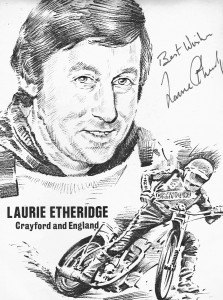 Laurie Etheridge’s well deserved Testimonial Season was celebrated on 14th September, when a Kent Kestrels side featuring Malcolm Simmons and Dave Jessup, in addition to current and former Crayford riders defeated a Hackney Hawks Past and Present team. In respect of the Kestrels League campaign, it was no surprise to see them slipping down the table to their lowest finish ever (fifteenth out of nineteen) when their averages show that none of last seasons top five riders were able to improve their numbers and with the exception of Barry Thomas (8.75), the other four all saw their averages drop by over a full point. Also, a London Road track that had always been such an impregnable fortress, leaked points at an alarming rate as Crayford suffered six devastating home League defeats. All this on the back of the close season departure of Peter Thorogood, the Kestrels founding father, former promoter, team manager, track curator and ‘Mr. Crayford’ in the eyes of many supporters. His replacement as team manager was former Kestrel rider and former secretary of the Speedway Riders Association, George Barclay. Silver linings came in the form of one of the finds of 1982, grasstrack ace Trevor Banks (7.62); an improved Michael Spinks (6.83); a vastly improved Paul Bosley (5.22), who shook off the effects of an injury hit previous season to increase his average whilst remaining an ever present; and the signing on loan from Wimbledon of Alan Mogridge (5.96) who by the end of 1982 was already a firm favourite with the fans. And once again Crayford entered the speedway record books with yet another never to be beaten result, when on Tuesday 26th October they trounced Milton Keynes 76-20. Thirteen 5-1′s, two 4-2′s and one 3-3 heat scores created two full and four paid maximums with only one rider, unfortunately skipper Laurie Etheridge, beaten by an opponent. But probably the most impressive statistic from such a poor season was that crowd numbers actually improved, proof indeed that Crayford fans were not fickle!
Laurie Etheridge’s well deserved Testimonial Season was celebrated on 14th September, when a Kent Kestrels side featuring Malcolm Simmons and Dave Jessup, in addition to current and former Crayford riders defeated a Hackney Hawks Past and Present team. In respect of the Kestrels League campaign, it was no surprise to see them slipping down the table to their lowest finish ever (fifteenth out of nineteen) when their averages show that none of last seasons top five riders were able to improve their numbers and with the exception of Barry Thomas (8.75), the other four all saw their averages drop by over a full point. Also, a London Road track that had always been such an impregnable fortress, leaked points at an alarming rate as Crayford suffered six devastating home League defeats. All this on the back of the close season departure of Peter Thorogood, the Kestrels founding father, former promoter, team manager, track curator and ‘Mr. Crayford’ in the eyes of many supporters. His replacement as team manager was former Kestrel rider and former secretary of the Speedway Riders Association, George Barclay. Silver linings came in the form of one of the finds of 1982, grasstrack ace Trevor Banks (7.62); an improved Michael Spinks (6.83); a vastly improved Paul Bosley (5.22), who shook off the effects of an injury hit previous season to increase his average whilst remaining an ever present; and the signing on loan from Wimbledon of Alan Mogridge (5.96) who by the end of 1982 was already a firm favourite with the fans. And once again Crayford entered the speedway record books with yet another never to be beaten result, when on Tuesday 26th October they trounced Milton Keynes 76-20. Thirteen 5-1′s, two 4-2′s and one 3-3 heat scores created two full and four paid maximums with only one rider, unfortunately skipper Laurie Etheridge, beaten by an opponent. But probably the most impressive statistic from such a poor season was that crowd numbers actually improved, proof indeed that Crayford fans were not fickle!
1983
George Barclay’s single term of tenure ended before the 1983 season replaced by former World number two Malcolm Simmons: highly unusually, doubling between riding for top division Wimbledon while managing the Kestrels.
Laurie Etheridge finally departed too with the captaincy transferring to Barry Thomas (9.69) and his team slot going to Kevin Teager (7.56) signed from Scunthorpe. With former junior Andy Galvin (6.72) replacing Spinks in spectacular fashion scoring nearly seven points a match in his first full season, the remainder of the team were unchanged from last year. Mind you, what a team – Paul Bosley (7.88) was named “Mr Up & Coming” by the Speedway Star in their New Year’s Honours List. And along with Bosley, both Alan Sage (6.63) and Alan Mogridge (6.60) improved on last years CMA’s. Trevor Banks (6.46) continued his dominance of the away tracks scoring 12 at Mildenhall, 13 at Newcastle, 13 at Peterborough, 11 at Long Eaton, 11 at Canterbury and 15 at Stoke, yet amazingly never broke into double figures at home! With an incredible six ever present riders, the only other to wear a Kestrel race jacket in ’83 was junior Mark Terry, who recorded 18 points from 14 rides for a very respectable 5.14 CMA. Undoubtedly the Kestrels had strength in depth and fully deserved their meteoric rise up the table to finish in third place just two points off the runners-up spot and the highest ever recorded League placing by a Crayford side. In fact, for a while in the well-appointed bars around the stadium, Kestrel fans allowed themselves the luxury of discussing an almost unthinkable subject – Crayford winning the National League! Unfortunately, both Newcastle and Mildenhall had other ideas but it was nice while it lasted.
Individually, two Crayford riders maintained an almost vice-like grip on the Silver Helmet Match-race Championship. Barry Thomas initially beat Steve McDermott at Berwick on 7th May and then successfully defended the title on six occasions against Rod Hunter (Newcastle), Mark Fiora (Edinburgh), Dave Perks (Long Eaton), Billy Burton (Boston), Paul Stead (Long Eaton) and Bruce Cribb (Berwick) before losing to Julian Parr at Scunthorpe on 27th June.
Then just 24 hours later the title returned back to Crayford when Kevin Teager defeated Parr at London Road. Teager then defeated Bob Garrad (Rye House) before losing to Steve Wilcock (Middlesbrough) on 12th July. Thomas reclaimed the title again on 23rd August defeating Jim McMillan (Glasgow); successfully defended it against Rod Hunter (Newcastle) before losing to Nigel Sparshott at Oxford on 1st September. And then five days later, Thomas repaid the compliment by winning the title back from Sparshott at Crayford, going on to successfully defend it against Pete Smith (Stoke) and Keith White (Milton Keynes) before finally losing his grip at Boston when beaten by Steve Lomas.
In addition to the success of the senior side, Crayford’s youngsters won the Southern Junior League Championship. Led by Mark Terry (10.00) and Richard Newnham (7.20) who were both ever present throughout the junior campaign and supported by Nick Smith (6.12), the young Kestrels were quite a force to be reckoned with. Especially at London Road, where they recorded some large victories including a maximum 20-4 defeat of local rivals Wimbledon. In fact, the juniors could have been an even stronger team had the vastly talented Brad Dowsett (10.67) not suffered a torn cartilage after just five matches, in four of which he had recorded paid maximums! Dave Gentry (4.00) was the only other rider to appear in a Crayford junior race jacket with a single ride in the 17-5 home victory over Oxford.
On Wednesday 26th October 1983, the final home meeting of the Kestrels’ finest season was the first leg of the end of year ‘play-off’ type event, the Supernational Final against League Champs, Newcastle. In a thriller the homesters emerged 48-47 victors – with the massively improved Paul Bosley clinching victory in the final heat.
Russell’s extended programme notes promised ‘See You All in 1984’; however, a mere four weeks later, a brief press statement announced that Crayford Speedway was to close and – with Len Silver leaving Waterden Road – the entire Kestrels operation would be moving to the East London venue, which would become the National League home of the ‘new’ Hackney Kestrels. For many Crayford loyalists the agony of the track closure was further compounded by seeing the unquestioned championship pedigree of the young Crayford outfit fulfilled wearing Hackney race-jackets in 1988: a double-winning side that included the much-loved Andy Galvin, Paul Bosley, Barry Thomas and Alan Mogridge; plus Galvin’s fellow Iwade-discovery, Paul Whittaker who by appearing in practice laps after the Newcastle meeting was actually the last rider ever to ride at Crayford Stadium.
The gambling conglomerate owners – with the planning consent of Bexley Council – had unbeknown to most Crayford fans, done a deal with a supermarket giant to demolish the stadium, have a Sainsbury’s super-store built; and in a near-impossibly small space between the new supermarket and the ubiquitous railway line, squeeze in a tiny, utterly functional dog track. So although the old stadium fell prey to the bull-dozers after a final dog meeting on 18th May 1985 somehow, Crayford remained – and remains to this day – on the Greyhound Racing map; but the new venue – with spectator access allowed down just one side and lighting stanchions on the centre green – simply designed out any possibility of installing a speedway track.
Gone but not forgotten, the Kestrels were to make one last appearance in team competition when on Sunday 3rd November 1985, an ex-Crayford side of Barry Thomas, Paul Woods, Alan Mogridge, Kevin Teager, Andy Galvin with guests Andrew Silver and Roger Johns raced at Arena Essex against a Hammers Select to celebrate Crayford hero Alan Sage’s Testimonial. Managed for the day by former Kestrel rider and Team Manager, George Barclay and resplendent in special commemorative red, yellow and black race jackets, Crayford were supported by a large crowd of former fans who had made the short journey over the Thames to show their appreciation to Sage for all his years of service and to see the Kestrels race for one last time.
The Legacy
And the legacy of Crayford was to fall into the hands of a small group of former management, riders and fans who went onto secure roles in speedway officialdom, rider development and journalism. Terry Russell, a fan who turned promoter after stepping in to save the Kestrels at the end of the 1980 season, went on to spend the next 30 years in speedway management. In addition to promoting at numerous tracks including Hackney, Eastbourne and Swindon, Russell has served on the SCB (Speedway Control Board); held the positions of both President and Chairman of the sports UK Governing body, the BSPA (British Speedway Promoters Association); was instrumental in selling the idea of live televised speedway to Sky; staged the first ever British Grand Prix at Hackney in 1995 and introduced the sport to Cardiff’s 70,000 capacity Millennium Stadium, which now plays host to the World’s biggest speedway event. Russell continues to work full-time in the sport as MD of Go Speed International, a media rights agency based just a couple of miles down the road from the old Crayford Stadium. Following his sacking before the start of the 1982 season, the Kestrels founding father Peter Thorogood, re-appeared as Team Manager at Arena Essex when speedway opened there in 1984. He was to spend the next 18 years at the Purfleet track, the highlight of which was when the Hammers swept all before them winning the British League Division Two Championship, Knock Out Cup and Four Team Tournament Finals in 1991. After nearly two decades of service, Thorogood was asked to “retire” at the beginning of 2002. Renowned as an excellent track curator and with over thirty years experience in speedway management, it was no surprise that his “retirement” didn’t last very long with Mildenhall hiring him as their new Track Manager just a few months later.
Alan Johns was a hugely popular rider who rode for the Kestrels from 1975 to 1980 making 175 League and Cup appearances (3rd highest in Crayford history) and scoring 1,013 points (4th highest in Crayford history). Following his retirement, Johns kept involved in the sport initially building scaled down speedway bikes for novices to learn their craft. This led to his involvement in youth development programs at both Eastbourne and Mildenhall where his skills as a teacher and scout of speedway talent resulted in over 20 ex-pupils going on to sign professional contracts including World Finalists Martin Dugard, Scott Nicholls and the late Lee Richardson. In January 2013, Johns returned to the sport and once again will be guiding potential speedway talent with the establishment of a new junior club and purpose built training track at Lakeside. ‘Gentleman’ George Barclay, who finished his riding career at Crayford in 1975 and returned briefly as Team Manager in 1982, remains one of the most respected figures in the sport. A former secretary of the Speedway Riders Association and committee member of the World Speedway Riders Association, Barclay along with his partner Linda, was instrumental in the creation of the National Speedway Museum in Broxbourne, Hertfordshire. In addition, he has been involved in running training schools at Rye House and more recently Lakeside, where although now in his seventies, it has been rumoured that Barclay still rides a few laps!
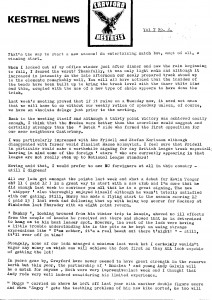 Former fans of the north-west Kent club also continue to participate and influence the sport. Most notably Bryn Williams, creator of the sport’s first ever fanzine, ‘Kestrels News’, the driving force behind the enormously successful CSSA (Crayford Speedway Supporters Association) and since 1983 a serial press relations officer, mic-man and eventually League Championship winning Team Manager; Alan Sargent was part of the syndicate that took control of the promotional rights at Arena Essex in 2000 and is currently General Manager of the Lakeside Hammers; Derek Barclay has become one of the most prolific programme contributors and media men in recent years, working with a number of clubs including Wimbledon, Boston, Mildenhall, Peterborough, Bournemouth, Poole, Stoke and Sittingbourne, where Barclay was press officer and announcer. More recently he moved from behind the mic to become Team Manager of 2012 Anglia Junior League runners-up, the Lakeside Young Hammers; Dave Welch, who’s expertise with the Kestrels’ CMAs led him into the long-held position as one of the sport’s most trusted statisticians and former CSSA Chairman Chris Golding, is time-keeper at National League Isle of Wight.
Former fans of the north-west Kent club also continue to participate and influence the sport. Most notably Bryn Williams, creator of the sport’s first ever fanzine, ‘Kestrels News’, the driving force behind the enormously successful CSSA (Crayford Speedway Supporters Association) and since 1983 a serial press relations officer, mic-man and eventually League Championship winning Team Manager; Alan Sargent was part of the syndicate that took control of the promotional rights at Arena Essex in 2000 and is currently General Manager of the Lakeside Hammers; Derek Barclay has become one of the most prolific programme contributors and media men in recent years, working with a number of clubs including Wimbledon, Boston, Mildenhall, Peterborough, Bournemouth, Poole, Stoke and Sittingbourne, where Barclay was press officer and announcer. More recently he moved from behind the mic to become Team Manager of 2012 Anglia Junior League runners-up, the Lakeside Young Hammers; Dave Welch, who’s expertise with the Kestrels’ CMAs led him into the long-held position as one of the sport’s most trusted statisticians and former CSSA Chairman Chris Golding, is time-keeper at National League Isle of Wight.
Crayford’s legacy also lives on in the record books with their 65-12 victory over Workington in July 1980 and their 76-20 victory over Milton Keynes in October 1982. And with the demise of both the thirteen and sixteen heat League and Cup match formats, these are records that will remain forever.
And the final mention must go to the organisation who began it all, the Bexleyheath and District Motorcycle Club who, over eighty years ago, first staged speedway at Crayford. They are still an active and well-supported organisation recognised as the biggest motorcycle trials club in the South East of England, holding their club meetings at a number of venues in Kent, Surrey and East Sussex.
2015 – The Anniversary meeting at Kent Kings, Sittingbourne
Crayford fans had to wait another thirty years before they were able to witness the clubs race jackets race ‘in anger’ again on the shale. Their patience was finally rewarded on Monday 13th April 2015 at Kent Speedway in Sittingbourne, with the staging of the Crayford Anniversary Invicta Pairs. The brainchild of Kestrel supporter and current Kent pressman, Derek Barclay and supported and sponsored by a group of Crayford fans (Ian Bradley, Chris Golding, Simon Horton, Kevin MacKenzie, Andy Morgan, Mark Shipman and Rowan Watt), the meeting was staged to commemorate two notable landmarks in Kent speedway history. Namely, the 40th anniversary of the birth of the Crayford Kestrels and, thanks to research originally conducted for this website, the 85th anniversary of the very first speedway meeting in Kent, which was held at the Crayford Fairfield on 21st April 1930. And providing a direct link to those by-gone days of Crayford Speedway was the attendance of Ray Guntrip whose father, John and uncle, Reg both rode at Crayford in the 1930s. (An action photograph of John Guntrip appears near the top of this page) Ray, along with his son and grandson had been invited to attend by the sponsors and spent the evening watching racing from the Directors Lounge.
This anniversary meeting was programmed as a Best Pairs event with all six teams representing clubs who had raced in the county, including the only current speedway team, the hosts Kent Kings. Local riders plus invited guests competed over the original 15-heat pairs format with a traditional 3,2,1,0 points scoring system.
The Crayford Highwaymen team were represented by Brendan Johnson (10pts) and Nick Lawrence (5pts) whilst the Crayford Kestrels side had some interesting links to the past. The team consisted of Harvie Banks (7pts), son of the former Kestrels star Trevor, who had traveled all the way from Cornwall to represent his dads old club and local Kings rider Danno Verge (9pts), whose mum used to support Crayford before following the team to Hackney, where she met Danno’s dad who was riding for the Kestrels at Waterden Road.
Both riders, resplendent in the ’1975 design’ Kestrels race jacket, rode with great passion and their opening heat 5-1 win was well received by the many fans who had traveled down the A2 to once again support their old club. The meeting went right down to the wire before the Kent Kings finally emerged victorious: Kent Kings 17, Crayford Kestrels 16, Romney Falcons 16, Crayford Highwaymen 15, Canterbury Crusaders 15 and Rochester Bombers 11.
The evening was also used as a mini-reunion for a number of former Kestrel riders, who attended as guests of the sponsors. Stars from the past included Laurie Etheridge, Alan Sage, Barry Thomas, Alan Johns, Pete Wigley, Bill Archer and Chris Tritton. And Nick Smith, star of the Kestrels Southern Junior League Championship winning side was also spotted supporting from the terraces. The former Crayford riders completed the evening by presenting the winning trophies to the Kent Kings duo before posing for a ‘blast from the past’ team photo on the track.
2019 - BORN AGAIN!
On February 11th, 2019 via this website and a dedicated social media feed, it was announced that the Kestrels will ride again! Crayford formally entered the Summer Sixes League (SSL), a six team competition based at Iwade Speedway. An amateur contest, joining the SSL marked the resurrection of the Crayford Amateur Speedway Club, originally established in 1935. Financed and driven by Mark Shipman, Kev Mackenzie and Dan Fisk, three long-time friends who met supporting the Kestrels back in the 1970s, the ethos behind the move was firstly to resurrect the Crayford name to see the red, yellow and black racing back on the shale in a competitive environment and secondly, to encourage and support grass roots speedway, an area of the sport badly in need of some ‘professional’ help. And with former Kestrel legend Laurie Etheridge accepting the role of honorary Club Chairman, the scene was set. Drawing the team from amateur stalwarts Will Little, Paul Whichello & Gavin Ware plus MSDL riders Jacob Clouting and Chris Watts, team manager Mark Shipman quickly cultivated a strong spirit amongst the squad. One that would see the the Kestrels overcome many issues, both on and off the track, to eventually win the 2019 SSL Championship on the last day of the season. This was a victorious return to the shale for Kent’s oldest speedway club and also saw the Crayford management and fans fulfil their goal of supporting grass roots speedway and encouraging new talent into the sport, ably illustrated by the fact that three of the Kestrels Championship winning team (Louis Bryant, Josh Couzins and Chris Laidlaw) all made their competitive speedway debuts this season. And the icing on the cake was novice reserve Louis Bryant winning the ‘SSL Most Improved Rider of the Season’, a fitting award for a great competitor and an influential member of the Crayford team. Louis has come along way from his unbeaten debut in May, when he was having to practise racing starts in the pits ahead of his first ever competitive race! In addition, Chris Laidlaw’s story ably illustrates the strength and closeness of the ‘Crayford Family’. He is the son of long-time Kestrels fans Tim and Sally, and up until April of this season hadn’t even sat on a speedway bike. Yet encouraged by everyone at the club, he progressed at such an amazing rate, he was able to go from team mechanic to making his competitive racing debut in the Kestrels final SSL match, where he scored 11pts from his four rides and sealed Crayford’s Championship win. The post-meeting presentation of the SSL Championship trophy and the individual medals to the Kestrel riders were greeted with war-cries from the large group of Crayford fans in attendance and celebrated with a traditional spraying of champagne. The Kestrels were well and truly back! 2020 - CRAYFORD’S 90th ANNIVERSARY SEASON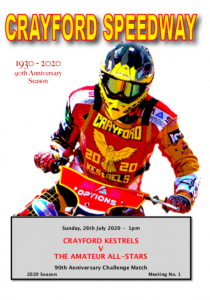 On a sunny but windy July afternoon in deepest Kent, speedway history was made when the UK’s first competitive team match of 2020 and the first ever since a government lock-down was held at Lydd Speedway. It also marked the inaugural meeting for Crayford at their new ‘home’ (not dissimilar in size to their old London Road circuit) and the 90th anniversary year of Crayford Speedway from its humble beginnings documented elsewhere on this page. Admittedly, a long way from their original home back in north-west Kent but until the club can locate and move to a venue closer to their old stomping ground, the tight but smooth Lydd circuit is a fitting venue to keep the Kestrels flag flying. Using the nucleus of their SSL Championship winning side from last seasons comp at Iwade, skipper Chris Watts (6.40) was joined by fellow heat-leaders former Kent King Jamie Couzins (8.00) and former Sittingbourne Crusader James Laker (6.00). And in a story that received TV coverage, the return of one of the original London Road Kestrels, 62yo Keith Cornell (9.87) back to the club that gave him his debut way back in 1981.
On a sunny but windy July afternoon in deepest Kent, speedway history was made when the UK’s first competitive team match of 2020 and the first ever since a government lock-down was held at Lydd Speedway. It also marked the inaugural meeting for Crayford at their new ‘home’ (not dissimilar in size to their old London Road circuit) and the 90th anniversary year of Crayford Speedway from its humble beginnings documented elsewhere on this page. Admittedly, a long way from their original home back in north-west Kent but until the club can locate and move to a venue closer to their old stomping ground, the tight but smooth Lydd circuit is a fitting venue to keep the Kestrels flag flying. Using the nucleus of their SSL Championship winning side from last seasons comp at Iwade, skipper Chris Watts (6.40) was joined by fellow heat-leaders former Kent King Jamie Couzins (8.00) and former Sittingbourne Crusader James Laker (6.00). And in a story that received TV coverage, the return of one of the original London Road Kestrels, 62yo Keith Cornell (9.87) back to the club that gave him his debut way back in 1981.
Cornell donning a Kestrels race jacket after a gap of 37 years provided the Crayford faithful with a tangible link back to their old London Road days and the fan favourite didn’t disappoint recording double-figure scores in all three fixtures! Chris Laidlaw (9.18) continued his amazing story with some very impressive performances in the first ever team matches of his fledgling career ably supported by last season’s SSL hero Will Little (8.27). Another interesting storyline running through the Kestrels team this season was the Couzins brothers racing together for the very first time. Former National League racer Jamie, joined his younger sibling Josh at the club and together they made a formidable combination and were the first brothers to ride in a Crayford team since 1936 when early pioneers John and Reg Guntrip competed.
In a climate where the entire country struggled with an enforced Government lockdown to deal with a global pandemic and with only a brief few months respite in restrictions, it was an impressive achievement that Crayford managed to stage any meetings at all, especially given the fact that many professional speedway clubs decided not to open their doors. As the search continues for a permanent home, the club has firmly put itself back on the speedway map as evidenced by the excellent coverage in the Speedway Star and the interest Crayford has received from around the world!
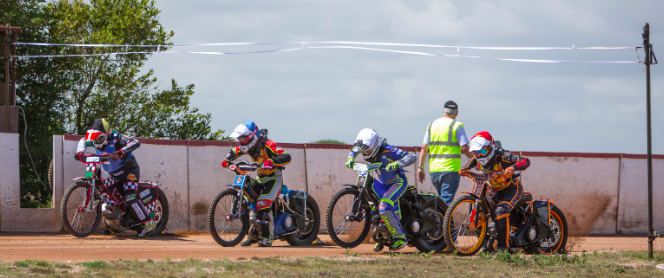
Tapes up for heat one of the first ever post-lockdown speedway match in the UK featuring brothers Josh (blue) & Jamie Couzins (red) in the Kestrels colours
The Kestrels faired less well in their other away match, a 4-rider/6-heat Development League style challenge at the Isle of Wight Wizards. Racing on one of the largest tracks in the country, a circuit more than twice the size of their Lydd base, Crayford were always going to find it a tough transition but an impressive maximum from captain Chris Watts gave the travelling Kestrels supporters plenty to cheer about. Billed as a historic first ‘overseas’ match for the club, history was also made when 19yo Roksana Brzeska made her Kestrels debut not only becoming the first Polish rider to race for Crayford but also the first woman to wear the red, yellow and black.
Back at Lydd, where the wet summer weather forced a number of cancellations, the Kestrels were finally able to complete all but one of their challenge matches by the seasons end, with the postponed visit of the Thurrock Hammers moved to next year. Josh Couzins (9.40), a novice in 2019 when he made his debut for Crayford in the SSL, continued his spectacular progression to top the Kestrels averages with 2-time British Vets Champion Keith Cornell (8.52), pocket rocket Will Little (7.55) and skipper Chris Watts (7.38) all providing solid support throughout the season. Unfortunately after scoring a 15-point maximum in the season opener against the Romney Falcons, Chris Laidlaw (5.11) suffered from a spectacular crash at Scunthorpe, which caused him to struggle for the remainder of the season with a shoulder injury. And finally, mention must go to the former National League legend Rob Hollingworth (10.00 G), who at the sprightly age of 65 guested twice for the Kestrels dropping just four points to opposition riders. Interestingly, Rob is another link back to the clubs old London Road days when he rode for Boston against the Kestrels in their first ever home meeting back in April 1975!

